Strategic Quality and Systems Management Report: Toyota Analysis
VerifiedAdded on 2023/01/19
|13
|3828
|80
Report
AI Summary
This report provides a comprehensive analysis of Toyota's strategic quality and systems management. It explores the importance of effective operations management in achieving organizational objectives, focusing on customer satisfaction, product quality, and waste reduction. The report evaluates Toyota's existing operations management processes, particularly its lean manufacturing approach and just-in-time inventory management, in relation to its strategic goals. Furthermore, it emphasizes the significance of quality management, including its impact on productivity, revenue, customer satisfaction, and brand image. The report delves into Toyota's use of Total Quality Management (TQM) and evaluates its effectiveness. It examines the planning of strategic quality changes, considering factors like competition, resources, and customer demands, and analyzes the resources, tools (Porter's Five Forces, quality audits, technology) used to support business processes. The report also evaluates the implications of planned strategic quality changes, including financial performance and customer satisfaction, and discusses systems for monitoring implementation, such as the PDCA cycle and employee empowerment. Finally, the report concludes with recommendations for improvement within the strategic quality management framework.
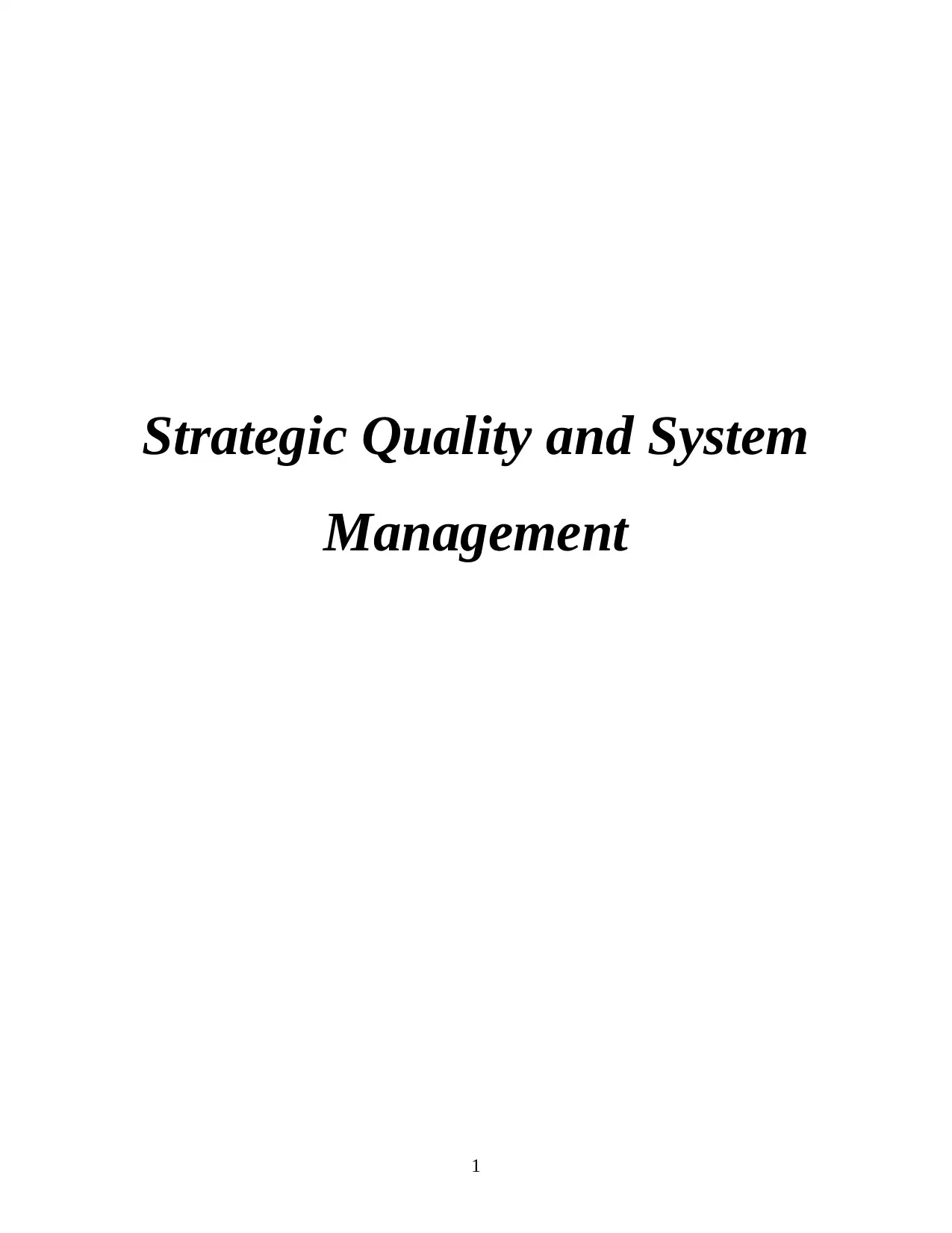
Strategic Quality and System
Management
1
Management
1
Paraphrase This Document
Need a fresh take? Get an instant paraphrase of this document with our AI Paraphraser
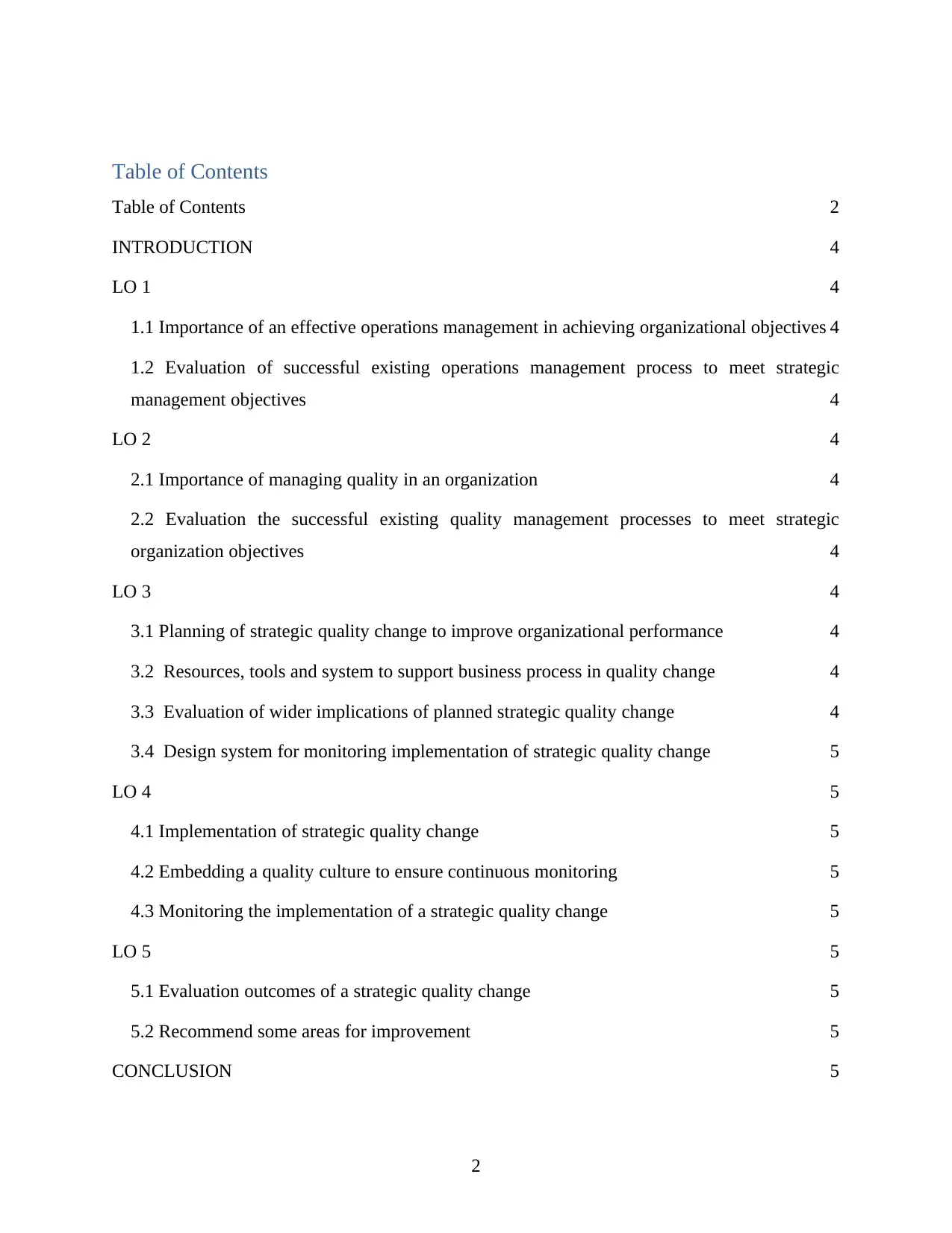
Table of Contents
Table of Contents 2
INTRODUCTION 4
LO 1 4
1.1 Importance of an effective operations management in achieving organizational objectives 4
1.2 Evaluation of successful existing operations management process to meet strategic
management objectives 4
LO 2 4
2.1 Importance of managing quality in an organization 4
2.2 Evaluation the successful existing quality management processes to meet strategic
organization objectives 4
LO 3 4
3.1 Planning of strategic quality change to improve organizational performance 4
3.2 Resources, tools and system to support business process in quality change 4
3.3 Evaluation of wider implications of planned strategic quality change 4
3.4 Design system for monitoring implementation of strategic quality change 5
LO 4 5
4.1 Implementation of strategic quality change 5
4.2 Embedding a quality culture to ensure continuous monitoring 5
4.3 Monitoring the implementation of a strategic quality change 5
LO 5 5
5.1 Evaluation outcomes of a strategic quality change 5
5.2 Recommend some areas for improvement 5
CONCLUSION 5
2
Table of Contents 2
INTRODUCTION 4
LO 1 4
1.1 Importance of an effective operations management in achieving organizational objectives 4
1.2 Evaluation of successful existing operations management process to meet strategic
management objectives 4
LO 2 4
2.1 Importance of managing quality in an organization 4
2.2 Evaluation the successful existing quality management processes to meet strategic
organization objectives 4
LO 3 4
3.1 Planning of strategic quality change to improve organizational performance 4
3.2 Resources, tools and system to support business process in quality change 4
3.3 Evaluation of wider implications of planned strategic quality change 4
3.4 Design system for monitoring implementation of strategic quality change 5
LO 4 5
4.1 Implementation of strategic quality change 5
4.2 Embedding a quality culture to ensure continuous monitoring 5
4.3 Monitoring the implementation of a strategic quality change 5
LO 5 5
5.1 Evaluation outcomes of a strategic quality change 5
5.2 Recommend some areas for improvement 5
CONCLUSION 5
2

REFERENCES 6
3
3
⊘ This is a preview!⊘
Do you want full access?
Subscribe today to unlock all pages.

Trusted by 1+ million students worldwide
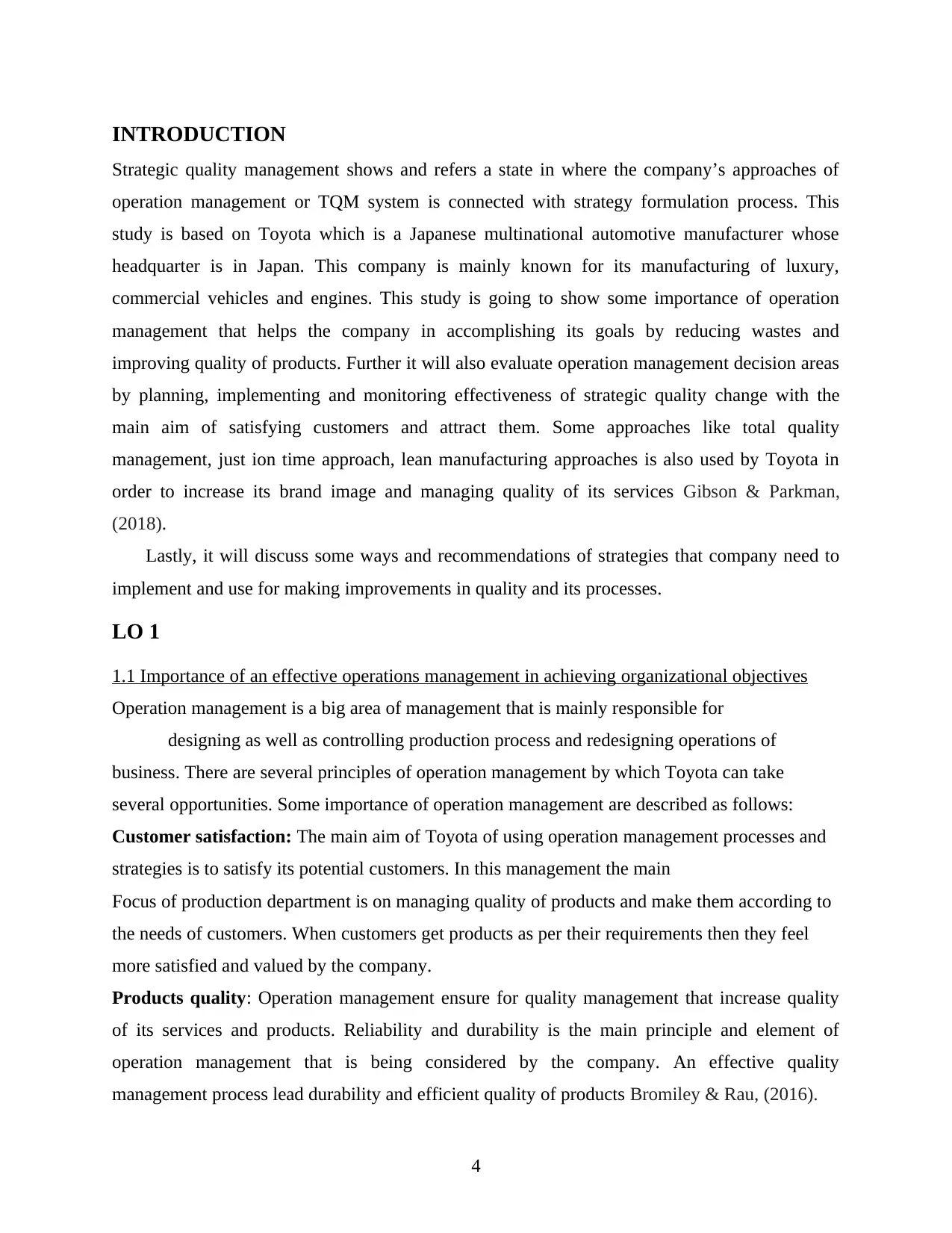
INTRODUCTION
Strategic quality management shows and refers a state in where the company’s approaches of
operation management or TQM system is connected with strategy formulation process. This
study is based on Toyota which is a Japanese multinational automotive manufacturer whose
headquarter is in Japan. This company is mainly known for its manufacturing of luxury,
commercial vehicles and engines. This study is going to show some importance of operation
management that helps the company in accomplishing its goals by reducing wastes and
improving quality of products. Further it will also evaluate operation management decision areas
by planning, implementing and monitoring effectiveness of strategic quality change with the
main aim of satisfying customers and attract them. Some approaches like total quality
management, just ion time approach, lean manufacturing approaches is also used by Toyota in
order to increase its brand image and managing quality of its services Gibson & Parkman,
(2018).
Lastly, it will discuss some ways and recommendations of strategies that company need to
implement and use for making improvements in quality and its processes.
LO 1
1.1 Importance of an effective operations management in achieving organizational objectives
Operation management is a big area of management that is mainly responsible for
designing as well as controlling production process and redesigning operations of
business. There are several principles of operation management by which Toyota can take
several opportunities. Some importance of operation management are described as follows:
Customer satisfaction: The main aim of Toyota of using operation management processes and
strategies is to satisfy its potential customers. In this management the main
Focus of production department is on managing quality of products and make them according to
the needs of customers. When customers get products as per their requirements then they feel
more satisfied and valued by the company.
Products quality: Operation management ensure for quality management that increase quality
of its services and products. Reliability and durability is the main principle and element of
operation management that is being considered by the company. An effective quality
management process lead durability and efficient quality of products Bromiley & Rau, (2016).
4
Strategic quality management shows and refers a state in where the company’s approaches of
operation management or TQM system is connected with strategy formulation process. This
study is based on Toyota which is a Japanese multinational automotive manufacturer whose
headquarter is in Japan. This company is mainly known for its manufacturing of luxury,
commercial vehicles and engines. This study is going to show some importance of operation
management that helps the company in accomplishing its goals by reducing wastes and
improving quality of products. Further it will also evaluate operation management decision areas
by planning, implementing and monitoring effectiveness of strategic quality change with the
main aim of satisfying customers and attract them. Some approaches like total quality
management, just ion time approach, lean manufacturing approaches is also used by Toyota in
order to increase its brand image and managing quality of its services Gibson & Parkman,
(2018).
Lastly, it will discuss some ways and recommendations of strategies that company need to
implement and use for making improvements in quality and its processes.
LO 1
1.1 Importance of an effective operations management in achieving organizational objectives
Operation management is a big area of management that is mainly responsible for
designing as well as controlling production process and redesigning operations of
business. There are several principles of operation management by which Toyota can take
several opportunities. Some importance of operation management are described as follows:
Customer satisfaction: The main aim of Toyota of using operation management processes and
strategies is to satisfy its potential customers. In this management the main
Focus of production department is on managing quality of products and make them according to
the needs of customers. When customers get products as per their requirements then they feel
more satisfied and valued by the company.
Products quality: Operation management ensure for quality management that increase quality
of its services and products. Reliability and durability is the main principle and element of
operation management that is being considered by the company. An effective quality
management process lead durability and efficient quality of products Bromiley & Rau, (2016).
4
Paraphrase This Document
Need a fresh take? Get an instant paraphrase of this document with our AI Paraphraser
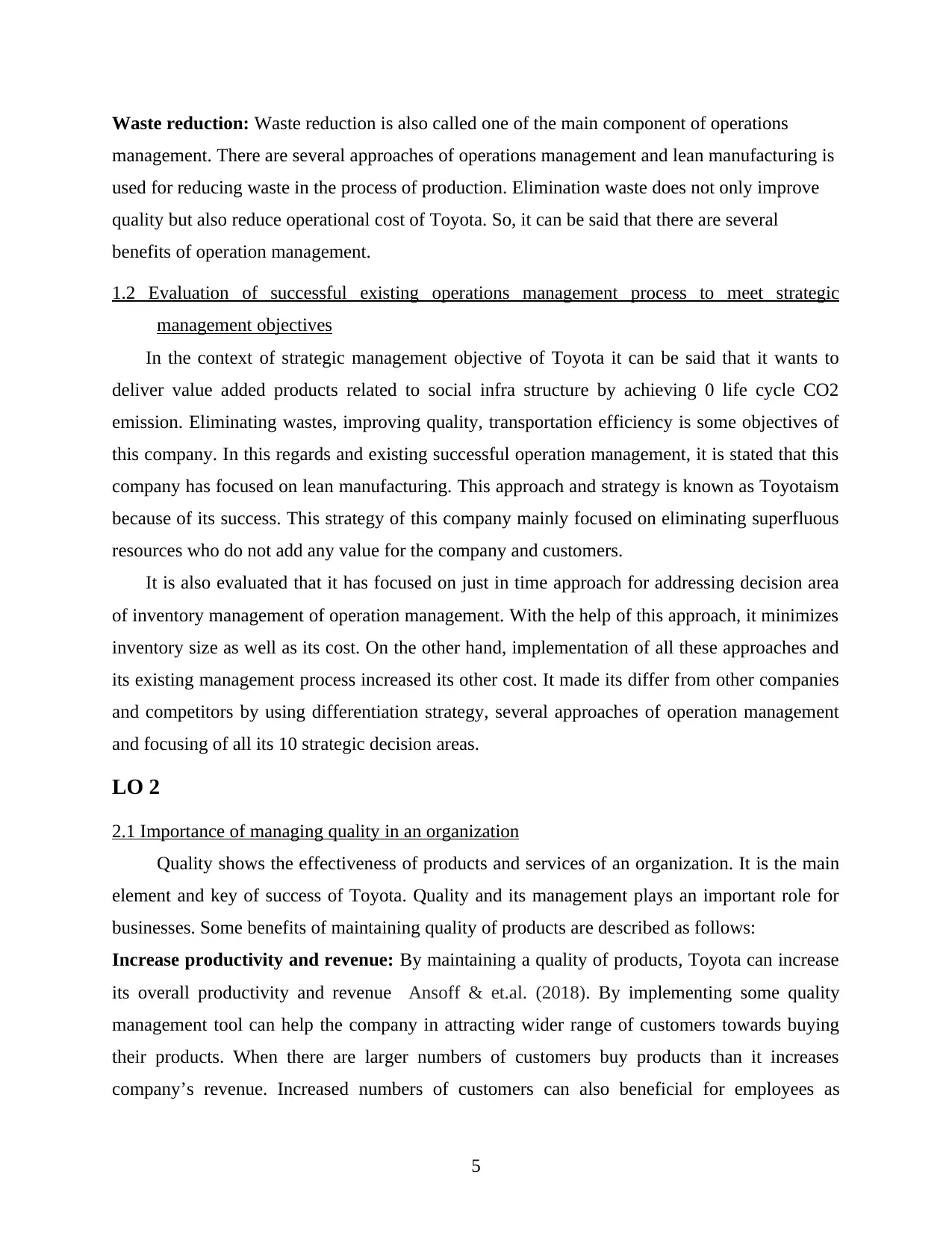
Waste reduction: Waste reduction is also called one of the main component of operations
management. There are several approaches of operations management and lean manufacturing is
used for reducing waste in the process of production. Elimination waste does not only improve
quality but also reduce operational cost of Toyota. So, it can be said that there are several
benefits of operation management.
1.2 Evaluation of successful existing operations management process to meet strategic
management objectives
In the context of strategic management objective of Toyota it can be said that it wants to
deliver value added products related to social infra structure by achieving 0 life cycle CO2
emission. Eliminating wastes, improving quality, transportation efficiency is some objectives of
this company. In this regards and existing successful operation management, it is stated that this
company has focused on lean manufacturing. This approach and strategy is known as Toyotaism
because of its success. This strategy of this company mainly focused on eliminating superfluous
resources who do not add any value for the company and customers.
It is also evaluated that it has focused on just in time approach for addressing decision area
of inventory management of operation management. With the help of this approach, it minimizes
inventory size as well as its cost. On the other hand, implementation of all these approaches and
its existing management process increased its other cost. It made its differ from other companies
and competitors by using differentiation strategy, several approaches of operation management
and focusing of all its 10 strategic decision areas.
LO 2
2.1 Importance of managing quality in an organization
Quality shows the effectiveness of products and services of an organization. It is the main
element and key of success of Toyota. Quality and its management plays an important role for
businesses. Some benefits of maintaining quality of products are described as follows:
Increase productivity and revenue: By maintaining a quality of products, Toyota can increase
its overall productivity and revenue Ansoff & et.al. (2018). By implementing some quality
management tool can help the company in attracting wider range of customers towards buying
their products. When there are larger numbers of customers buy products than it increases
company’s revenue. Increased numbers of customers can also beneficial for employees as
5
management. There are several approaches of operations management and lean manufacturing is
used for reducing waste in the process of production. Elimination waste does not only improve
quality but also reduce operational cost of Toyota. So, it can be said that there are several
benefits of operation management.
1.2 Evaluation of successful existing operations management process to meet strategic
management objectives
In the context of strategic management objective of Toyota it can be said that it wants to
deliver value added products related to social infra structure by achieving 0 life cycle CO2
emission. Eliminating wastes, improving quality, transportation efficiency is some objectives of
this company. In this regards and existing successful operation management, it is stated that this
company has focused on lean manufacturing. This approach and strategy is known as Toyotaism
because of its success. This strategy of this company mainly focused on eliminating superfluous
resources who do not add any value for the company and customers.
It is also evaluated that it has focused on just in time approach for addressing decision area
of inventory management of operation management. With the help of this approach, it minimizes
inventory size as well as its cost. On the other hand, implementation of all these approaches and
its existing management process increased its other cost. It made its differ from other companies
and competitors by using differentiation strategy, several approaches of operation management
and focusing of all its 10 strategic decision areas.
LO 2
2.1 Importance of managing quality in an organization
Quality shows the effectiveness of products and services of an organization. It is the main
element and key of success of Toyota. Quality and its management plays an important role for
businesses. Some benefits of maintaining quality of products are described as follows:
Increase productivity and revenue: By maintaining a quality of products, Toyota can increase
its overall productivity and revenue Ansoff & et.al. (2018). By implementing some quality
management tool can help the company in attracting wider range of customers towards buying
their products. When there are larger numbers of customers buy products than it increases
company’s revenue. Increased numbers of customers can also beneficial for employees as
5
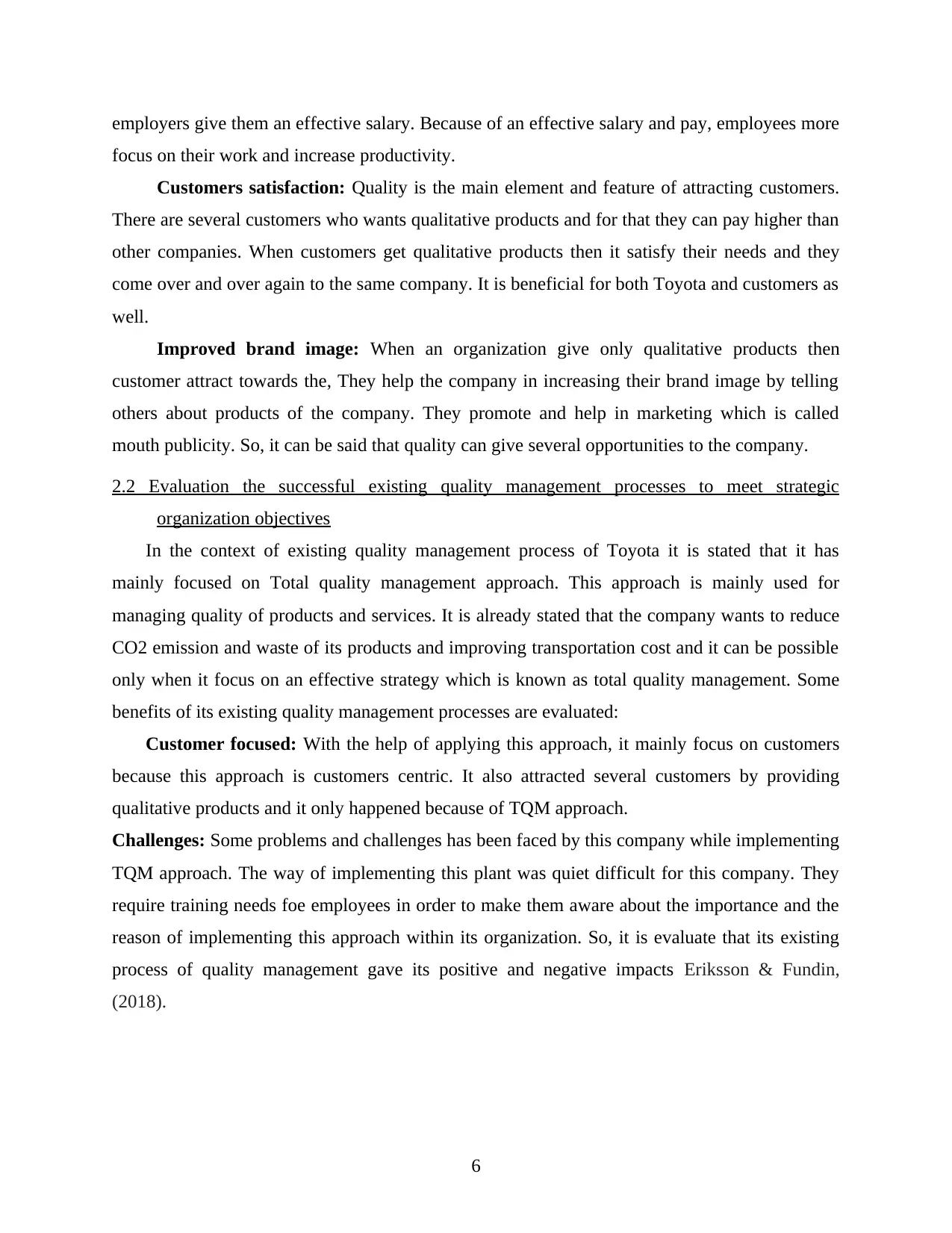
employers give them an effective salary. Because of an effective salary and pay, employees more
focus on their work and increase productivity.
Customers satisfaction: Quality is the main element and feature of attracting customers.
There are several customers who wants qualitative products and for that they can pay higher than
other companies. When customers get qualitative products then it satisfy their needs and they
come over and over again to the same company. It is beneficial for both Toyota and customers as
well.
Improved brand image: When an organization give only qualitative products then
customer attract towards the, They help the company in increasing their brand image by telling
others about products of the company. They promote and help in marketing which is called
mouth publicity. So, it can be said that quality can give several opportunities to the company.
2.2 Evaluation the successful existing quality management processes to meet strategic
organization objectives
In the context of existing quality management process of Toyota it is stated that it has
mainly focused on Total quality management approach. This approach is mainly used for
managing quality of products and services. It is already stated that the company wants to reduce
CO2 emission and waste of its products and improving transportation cost and it can be possible
only when it focus on an effective strategy which is known as total quality management. Some
benefits of its existing quality management processes are evaluated:
Customer focused: With the help of applying this approach, it mainly focus on customers
because this approach is customers centric. It also attracted several customers by providing
qualitative products and it only happened because of TQM approach.
Challenges: Some problems and challenges has been faced by this company while implementing
TQM approach. The way of implementing this plant was quiet difficult for this company. They
require training needs foe employees in order to make them aware about the importance and the
reason of implementing this approach within its organization. So, it is evaluate that its existing
process of quality management gave its positive and negative impacts Eriksson & Fundin,
(2018).
6
focus on their work and increase productivity.
Customers satisfaction: Quality is the main element and feature of attracting customers.
There are several customers who wants qualitative products and for that they can pay higher than
other companies. When customers get qualitative products then it satisfy their needs and they
come over and over again to the same company. It is beneficial for both Toyota and customers as
well.
Improved brand image: When an organization give only qualitative products then
customer attract towards the, They help the company in increasing their brand image by telling
others about products of the company. They promote and help in marketing which is called
mouth publicity. So, it can be said that quality can give several opportunities to the company.
2.2 Evaluation the successful existing quality management processes to meet strategic
organization objectives
In the context of existing quality management process of Toyota it is stated that it has
mainly focused on Total quality management approach. This approach is mainly used for
managing quality of products and services. It is already stated that the company wants to reduce
CO2 emission and waste of its products and improving transportation cost and it can be possible
only when it focus on an effective strategy which is known as total quality management. Some
benefits of its existing quality management processes are evaluated:
Customer focused: With the help of applying this approach, it mainly focus on customers
because this approach is customers centric. It also attracted several customers by providing
qualitative products and it only happened because of TQM approach.
Challenges: Some problems and challenges has been faced by this company while implementing
TQM approach. The way of implementing this plant was quiet difficult for this company. They
require training needs foe employees in order to make them aware about the importance and the
reason of implementing this approach within its organization. So, it is evaluate that its existing
process of quality management gave its positive and negative impacts Eriksson & Fundin,
(2018).
6
⊘ This is a preview!⊘
Do you want full access?
Subscribe today to unlock all pages.

Trusted by 1+ million students worldwide
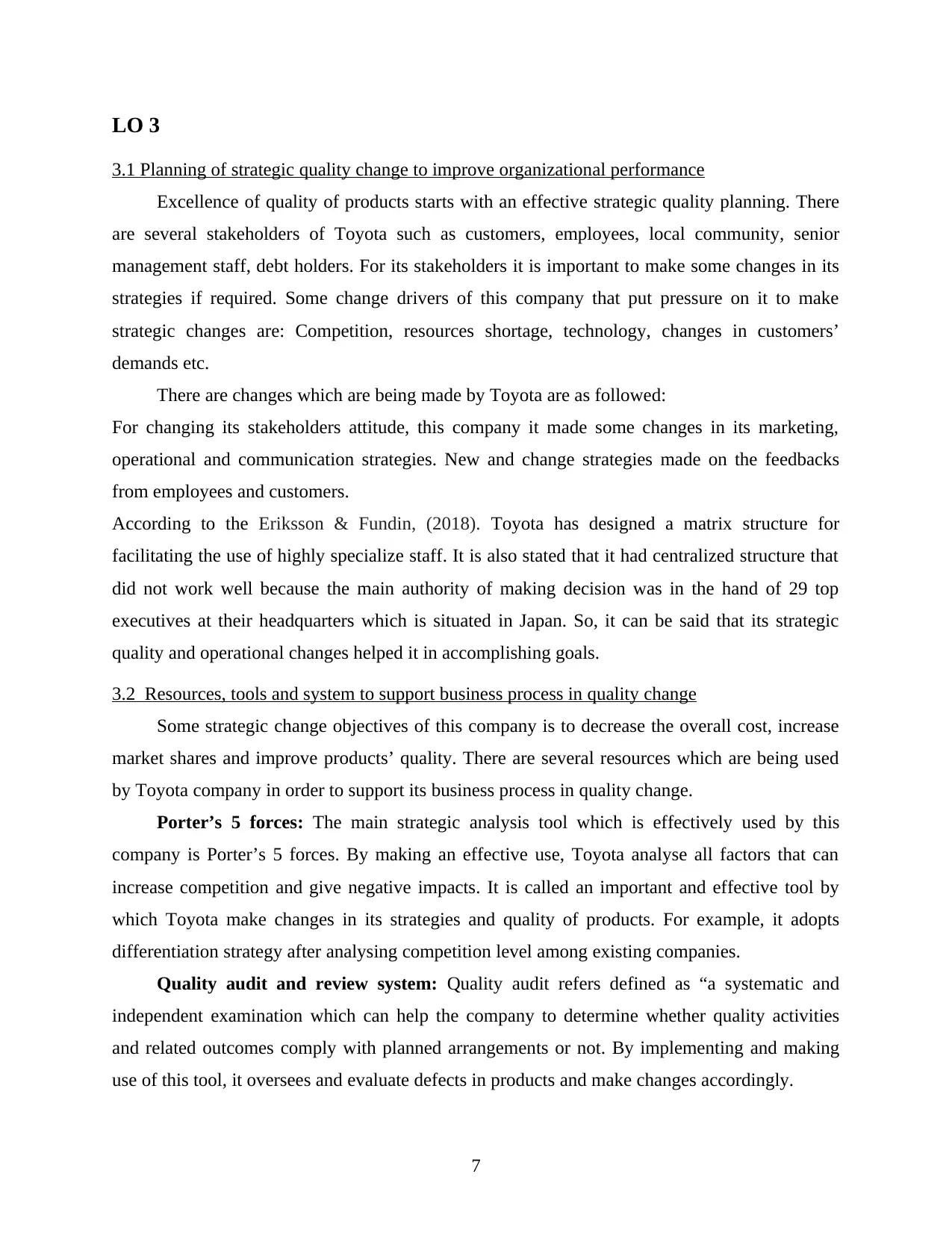
LO 3
3.1 Planning of strategic quality change to improve organizational performance
Excellence of quality of products starts with an effective strategic quality planning. There
are several stakeholders of Toyota such as customers, employees, local community, senior
management staff, debt holders. For its stakeholders it is important to make some changes in its
strategies if required. Some change drivers of this company that put pressure on it to make
strategic changes are: Competition, resources shortage, technology, changes in customers’
demands etc.
There are changes which are being made by Toyota are as followed:
For changing its stakeholders attitude, this company it made some changes in its marketing,
operational and communication strategies. New and change strategies made on the feedbacks
from employees and customers.
According to the Eriksson & Fundin, (2018). Toyota has designed a matrix structure for
facilitating the use of highly specialize staff. It is also stated that it had centralized structure that
did not work well because the main authority of making decision was in the hand of 29 top
executives at their headquarters which is situated in Japan. So, it can be said that its strategic
quality and operational changes helped it in accomplishing goals.
3.2 Resources, tools and system to support business process in quality change
Some strategic change objectives of this company is to decrease the overall cost, increase
market shares and improve products’ quality. There are several resources which are being used
by Toyota company in order to support its business process in quality change.
Porter’s 5 forces: The main strategic analysis tool which is effectively used by this
company is Porter’s 5 forces. By making an effective use, Toyota analyse all factors that can
increase competition and give negative impacts. It is called an important and effective tool by
which Toyota make changes in its strategies and quality of products. For example, it adopts
differentiation strategy after analysing competition level among existing companies.
Quality audit and review system: Quality audit refers defined as “a systematic and
independent examination which can help the company to determine whether quality activities
and related outcomes comply with planned arrangements or not. By implementing and making
use of this tool, it oversees and evaluate defects in products and make changes accordingly.
7
3.1 Planning of strategic quality change to improve organizational performance
Excellence of quality of products starts with an effective strategic quality planning. There
are several stakeholders of Toyota such as customers, employees, local community, senior
management staff, debt holders. For its stakeholders it is important to make some changes in its
strategies if required. Some change drivers of this company that put pressure on it to make
strategic changes are: Competition, resources shortage, technology, changes in customers’
demands etc.
There are changes which are being made by Toyota are as followed:
For changing its stakeholders attitude, this company it made some changes in its marketing,
operational and communication strategies. New and change strategies made on the feedbacks
from employees and customers.
According to the Eriksson & Fundin, (2018). Toyota has designed a matrix structure for
facilitating the use of highly specialize staff. It is also stated that it had centralized structure that
did not work well because the main authority of making decision was in the hand of 29 top
executives at their headquarters which is situated in Japan. So, it can be said that its strategic
quality and operational changes helped it in accomplishing goals.
3.2 Resources, tools and system to support business process in quality change
Some strategic change objectives of this company is to decrease the overall cost, increase
market shares and improve products’ quality. There are several resources which are being used
by Toyota company in order to support its business process in quality change.
Porter’s 5 forces: The main strategic analysis tool which is effectively used by this
company is Porter’s 5 forces. By making an effective use, Toyota analyse all factors that can
increase competition and give negative impacts. It is called an important and effective tool by
which Toyota make changes in its strategies and quality of products. For example, it adopts
differentiation strategy after analysing competition level among existing companies.
Quality audit and review system: Quality audit refers defined as “a systematic and
independent examination which can help the company to determine whether quality activities
and related outcomes comply with planned arrangements or not. By implementing and making
use of this tool, it oversees and evaluate defects in products and make changes accordingly.
7
Paraphrase This Document
Need a fresh take? Get an instant paraphrase of this document with our AI Paraphraser
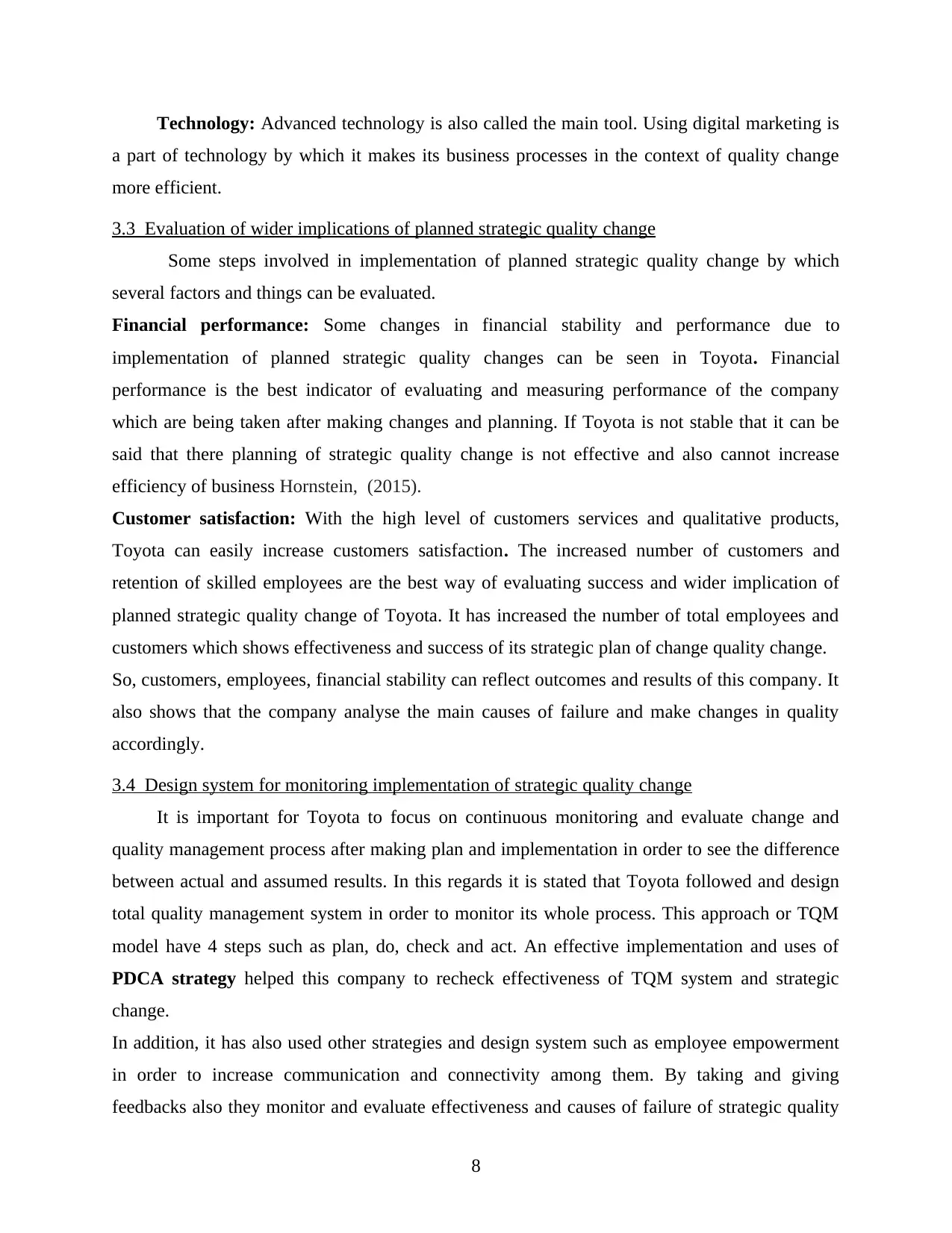
Technology: Advanced technology is also called the main tool. Using digital marketing is
a part of technology by which it makes its business processes in the context of quality change
more efficient.
3.3 Evaluation of wider implications of planned strategic quality change
Some steps involved in implementation of planned strategic quality change by which
several factors and things can be evaluated.
Financial performance: Some changes in financial stability and performance due to
implementation of planned strategic quality changes can be seen in Toyota. Financial
performance is the best indicator of evaluating and measuring performance of the company
which are being taken after making changes and planning. If Toyota is not stable that it can be
said that there planning of strategic quality change is not effective and also cannot increase
efficiency of business Hornstein, (2015).
Customer satisfaction: With the high level of customers services and qualitative products,
Toyota can easily increase customers satisfaction. The increased number of customers and
retention of skilled employees are the best way of evaluating success and wider implication of
planned strategic quality change of Toyota. It has increased the number of total employees and
customers which shows effectiveness and success of its strategic plan of change quality change.
So, customers, employees, financial stability can reflect outcomes and results of this company. It
also shows that the company analyse the main causes of failure and make changes in quality
accordingly.
3.4 Design system for monitoring implementation of strategic quality change
It is important for Toyota to focus on continuous monitoring and evaluate change and
quality management process after making plan and implementation in order to see the difference
between actual and assumed results. In this regards it is stated that Toyota followed and design
total quality management system in order to monitor its whole process. This approach or TQM
model have 4 steps such as plan, do, check and act. An effective implementation and uses of
PDCA strategy helped this company to recheck effectiveness of TQM system and strategic
change.
In addition, it has also used other strategies and design system such as employee empowerment
in order to increase communication and connectivity among them. By taking and giving
feedbacks also they monitor and evaluate effectiveness and causes of failure of strategic quality
8
a part of technology by which it makes its business processes in the context of quality change
more efficient.
3.3 Evaluation of wider implications of planned strategic quality change
Some steps involved in implementation of planned strategic quality change by which
several factors and things can be evaluated.
Financial performance: Some changes in financial stability and performance due to
implementation of planned strategic quality changes can be seen in Toyota. Financial
performance is the best indicator of evaluating and measuring performance of the company
which are being taken after making changes and planning. If Toyota is not stable that it can be
said that there planning of strategic quality change is not effective and also cannot increase
efficiency of business Hornstein, (2015).
Customer satisfaction: With the high level of customers services and qualitative products,
Toyota can easily increase customers satisfaction. The increased number of customers and
retention of skilled employees are the best way of evaluating success and wider implication of
planned strategic quality change of Toyota. It has increased the number of total employees and
customers which shows effectiveness and success of its strategic plan of change quality change.
So, customers, employees, financial stability can reflect outcomes and results of this company. It
also shows that the company analyse the main causes of failure and make changes in quality
accordingly.
3.4 Design system for monitoring implementation of strategic quality change
It is important for Toyota to focus on continuous monitoring and evaluate change and
quality management process after making plan and implementation in order to see the difference
between actual and assumed results. In this regards it is stated that Toyota followed and design
total quality management system in order to monitor its whole process. This approach or TQM
model have 4 steps such as plan, do, check and act. An effective implementation and uses of
PDCA strategy helped this company to recheck effectiveness of TQM system and strategic
change.
In addition, it has also used other strategies and design system such as employee empowerment
in order to increase communication and connectivity among them. By taking and giving
feedbacks also they monitor and evaluate effectiveness and causes of failure of strategic quality
8

change plan. Both these ways and strategies are called the best action plan for driving the quality
change successfully. Training and development to employees can also be the best design
system for increasing as well as monitoring of strategic quality change. Benchmarking KPI,
own performance reviews are some other techniques that has been used by Toyota for measuring
as well as evaluating effectiveness of its quality change plan Ross, (2017).
LO 4
4.1 Implementation of strategic quality change
Implementation of strategic quality change was quite difficult task than executing actual
change strategies for quality. Some steps and strategies involved in implementation of strategic
quality change which are as follows:
Organizational structure : Changes in structure like corporate structure is called the main
step which made implementation of change process successful. According to this structure, all
stakeholders given equal chance and an opportunity to take decision and give suggestion in the
process of decision making.
Collaboration and teamwork: By bringing all stakeholders at single level, they made
implementation process more successful By bringing out at common stage, they told the
importance of change process and the reason of implementing approaches of operations
management Jacobs, Swink & Linderman, (2015).
4.2 Embedding a quality culture to ensure continuous monitoring
Quality culture can help the company in making sure that they maintain a standard of
quality which is incorporated in to the entire operations of the company that can help Toyota in
the development of making its environment qualitative. The main aim of maintaining a quality
culture is to increase customers as well as employees satisfaction. For making effectiveness of its
culture, Toyota make several changes in order to make sure the success and effectiveness of the
process.
Quality culture of Toyota is mainly based on some principles such as collaboration and
group work with the main aim of accomplishing a common target and goal. For this principle
they try to bring all stakeholders like customers, employees and suppliers together for
successfully implementing and maintaining a quality culture of the quality change. Equality is
other principle and for making them respected and increasing quality culture, this company treats
9
change successfully. Training and development to employees can also be the best design
system for increasing as well as monitoring of strategic quality change. Benchmarking KPI,
own performance reviews are some other techniques that has been used by Toyota for measuring
as well as evaluating effectiveness of its quality change plan Ross, (2017).
LO 4
4.1 Implementation of strategic quality change
Implementation of strategic quality change was quite difficult task than executing actual
change strategies for quality. Some steps and strategies involved in implementation of strategic
quality change which are as follows:
Organizational structure : Changes in structure like corporate structure is called the main
step which made implementation of change process successful. According to this structure, all
stakeholders given equal chance and an opportunity to take decision and give suggestion in the
process of decision making.
Collaboration and teamwork: By bringing all stakeholders at single level, they made
implementation process more successful By bringing out at common stage, they told the
importance of change process and the reason of implementing approaches of operations
management Jacobs, Swink & Linderman, (2015).
4.2 Embedding a quality culture to ensure continuous monitoring
Quality culture can help the company in making sure that they maintain a standard of
quality which is incorporated in to the entire operations of the company that can help Toyota in
the development of making its environment qualitative. The main aim of maintaining a quality
culture is to increase customers as well as employees satisfaction. For making effectiveness of its
culture, Toyota make several changes in order to make sure the success and effectiveness of the
process.
Quality culture of Toyota is mainly based on some principles such as collaboration and
group work with the main aim of accomplishing a common target and goal. For this principle
they try to bring all stakeholders like customers, employees and suppliers together for
successfully implementing and maintaining a quality culture of the quality change. Equality is
other principle and for making them respected and increasing quality culture, this company treats
9
⊘ This is a preview!⊘
Do you want full access?
Subscribe today to unlock all pages.

Trusted by 1+ million students worldwide
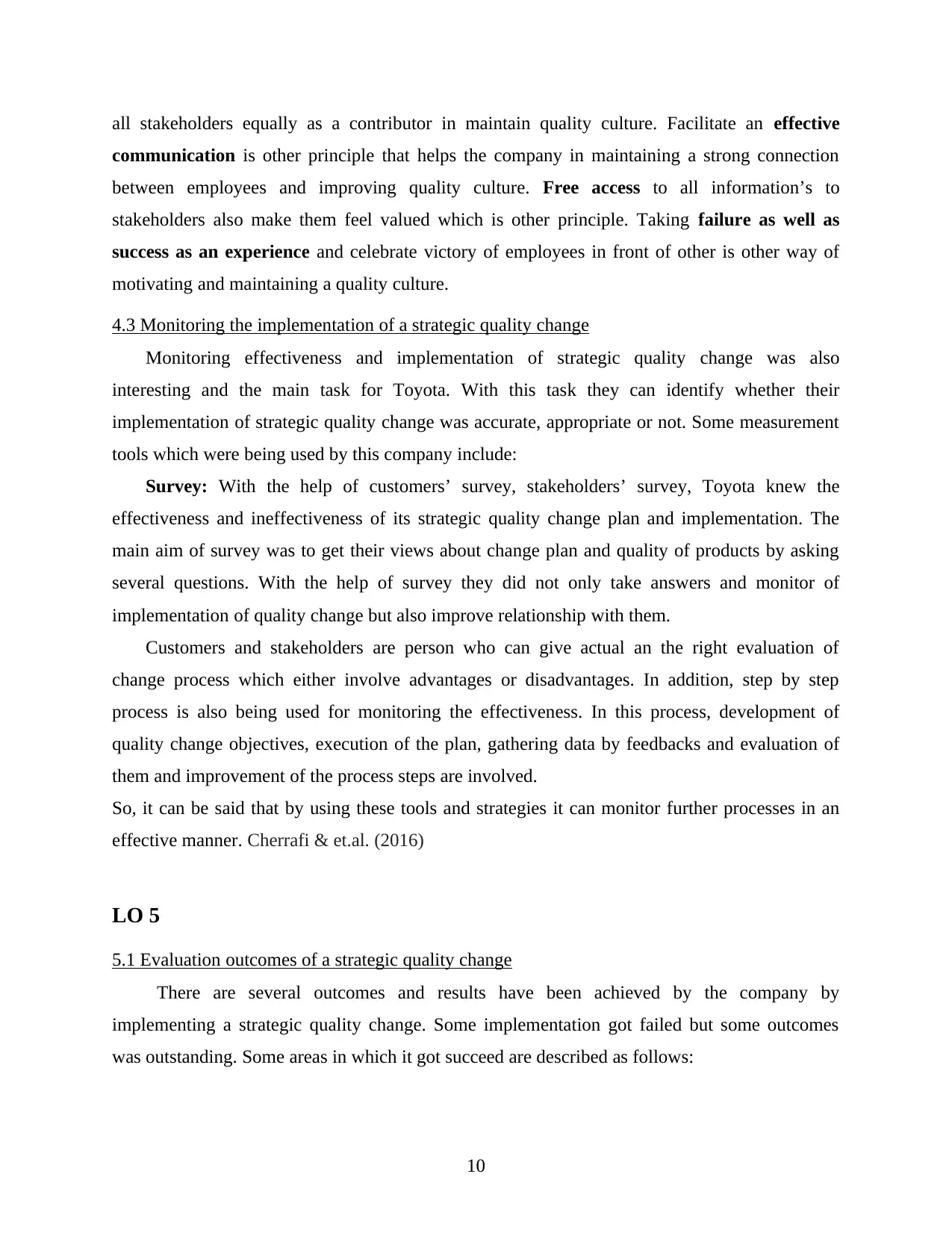
all stakeholders equally as a contributor in maintain quality culture. Facilitate an effective
communication is other principle that helps the company in maintaining a strong connection
between employees and improving quality culture. Free access to all information’s to
stakeholders also make them feel valued which is other principle. Taking failure as well as
success as an experience and celebrate victory of employees in front of other is other way of
motivating and maintaining a quality culture.
4.3 Monitoring the implementation of a strategic quality change
Monitoring effectiveness and implementation of strategic quality change was also
interesting and the main task for Toyota. With this task they can identify whether their
implementation of strategic quality change was accurate, appropriate or not. Some measurement
tools which were being used by this company include:
Survey: With the help of customers’ survey, stakeholders’ survey, Toyota knew the
effectiveness and ineffectiveness of its strategic quality change plan and implementation. The
main aim of survey was to get their views about change plan and quality of products by asking
several questions. With the help of survey they did not only take answers and monitor of
implementation of quality change but also improve relationship with them.
Customers and stakeholders are person who can give actual an the right evaluation of
change process which either involve advantages or disadvantages. In addition, step by step
process is also being used for monitoring the effectiveness. In this process, development of
quality change objectives, execution of the plan, gathering data by feedbacks and evaluation of
them and improvement of the process steps are involved.
So, it can be said that by using these tools and strategies it can monitor further processes in an
effective manner. Cherrafi & et.al. (2016)
LO 5
5.1 Evaluation outcomes of a strategic quality change
There are several outcomes and results have been achieved by the company by
implementing a strategic quality change. Some implementation got failed but some outcomes
was outstanding. Some areas in which it got succeed are described as follows:
10
communication is other principle that helps the company in maintaining a strong connection
between employees and improving quality culture. Free access to all information’s to
stakeholders also make them feel valued which is other principle. Taking failure as well as
success as an experience and celebrate victory of employees in front of other is other way of
motivating and maintaining a quality culture.
4.3 Monitoring the implementation of a strategic quality change
Monitoring effectiveness and implementation of strategic quality change was also
interesting and the main task for Toyota. With this task they can identify whether their
implementation of strategic quality change was accurate, appropriate or not. Some measurement
tools which were being used by this company include:
Survey: With the help of customers’ survey, stakeholders’ survey, Toyota knew the
effectiveness and ineffectiveness of its strategic quality change plan and implementation. The
main aim of survey was to get their views about change plan and quality of products by asking
several questions. With the help of survey they did not only take answers and monitor of
implementation of quality change but also improve relationship with them.
Customers and stakeholders are person who can give actual an the right evaluation of
change process which either involve advantages or disadvantages. In addition, step by step
process is also being used for monitoring the effectiveness. In this process, development of
quality change objectives, execution of the plan, gathering data by feedbacks and evaluation of
them and improvement of the process steps are involved.
So, it can be said that by using these tools and strategies it can monitor further processes in an
effective manner. Cherrafi & et.al. (2016)
LO 5
5.1 Evaluation outcomes of a strategic quality change
There are several outcomes and results have been achieved by the company by
implementing a strategic quality change. Some implementation got failed but some outcomes
was outstanding. Some areas in which it got succeed are described as follows:
10
Paraphrase This Document
Need a fresh take? Get an instant paraphrase of this document with our AI Paraphraser
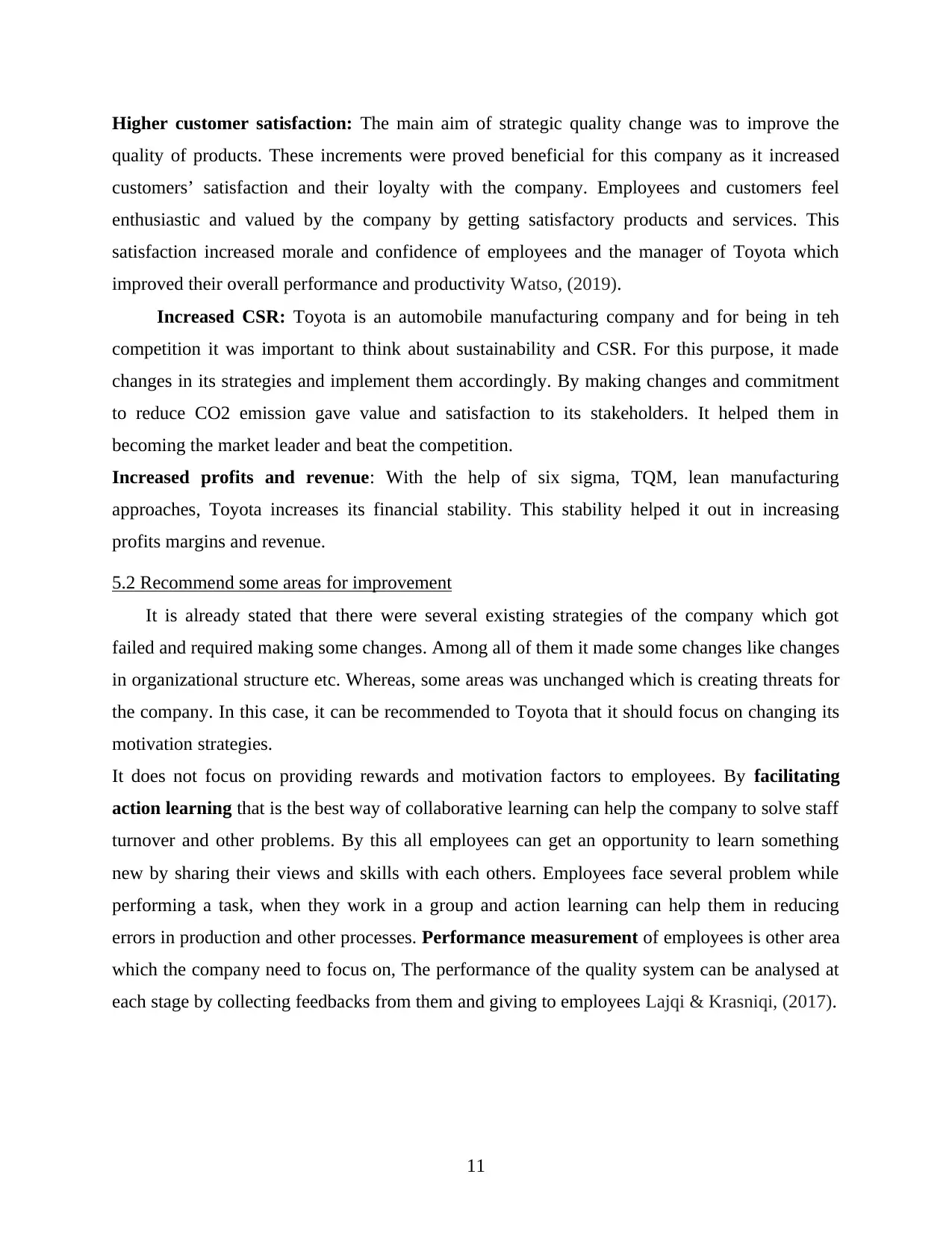
Higher customer satisfaction: The main aim of strategic quality change was to improve the
quality of products. These increments were proved beneficial for this company as it increased
customers’ satisfaction and their loyalty with the company. Employees and customers feel
enthusiastic and valued by the company by getting satisfactory products and services. This
satisfaction increased morale and confidence of employees and the manager of Toyota which
improved their overall performance and productivity Watso, (2019).
Increased CSR: Toyota is an automobile manufacturing company and for being in teh
competition it was important to think about sustainability and CSR. For this purpose, it made
changes in its strategies and implement them accordingly. By making changes and commitment
to reduce CO2 emission gave value and satisfaction to its stakeholders. It helped them in
becoming the market leader and beat the competition.
Increased profits and revenue: With the help of six sigma, TQM, lean manufacturing
approaches, Toyota increases its financial stability. This stability helped it out in increasing
profits margins and revenue.
5.2 Recommend some areas for improvement
It is already stated that there were several existing strategies of the company which got
failed and required making some changes. Among all of them it made some changes like changes
in organizational structure etc. Whereas, some areas was unchanged which is creating threats for
the company. In this case, it can be recommended to Toyota that it should focus on changing its
motivation strategies.
It does not focus on providing rewards and motivation factors to employees. By facilitating
action learning that is the best way of collaborative learning can help the company to solve staff
turnover and other problems. By this all employees can get an opportunity to learn something
new by sharing their views and skills with each others. Employees face several problem while
performing a task, when they work in a group and action learning can help them in reducing
errors in production and other processes. Performance measurement of employees is other area
which the company need to focus on, The performance of the quality system can be analysed at
each stage by collecting feedbacks from them and giving to employees Lajqi & Krasniqi, (2017).
11
quality of products. These increments were proved beneficial for this company as it increased
customers’ satisfaction and their loyalty with the company. Employees and customers feel
enthusiastic and valued by the company by getting satisfactory products and services. This
satisfaction increased morale and confidence of employees and the manager of Toyota which
improved their overall performance and productivity Watso, (2019).
Increased CSR: Toyota is an automobile manufacturing company and for being in teh
competition it was important to think about sustainability and CSR. For this purpose, it made
changes in its strategies and implement them accordingly. By making changes and commitment
to reduce CO2 emission gave value and satisfaction to its stakeholders. It helped them in
becoming the market leader and beat the competition.
Increased profits and revenue: With the help of six sigma, TQM, lean manufacturing
approaches, Toyota increases its financial stability. This stability helped it out in increasing
profits margins and revenue.
5.2 Recommend some areas for improvement
It is already stated that there were several existing strategies of the company which got
failed and required making some changes. Among all of them it made some changes like changes
in organizational structure etc. Whereas, some areas was unchanged which is creating threats for
the company. In this case, it can be recommended to Toyota that it should focus on changing its
motivation strategies.
It does not focus on providing rewards and motivation factors to employees. By facilitating
action learning that is the best way of collaborative learning can help the company to solve staff
turnover and other problems. By this all employees can get an opportunity to learn something
new by sharing their views and skills with each others. Employees face several problem while
performing a task, when they work in a group and action learning can help them in reducing
errors in production and other processes. Performance measurement of employees is other area
which the company need to focus on, The performance of the quality system can be analysed at
each stage by collecting feedbacks from them and giving to employees Lajqi & Krasniqi, (2017).
11
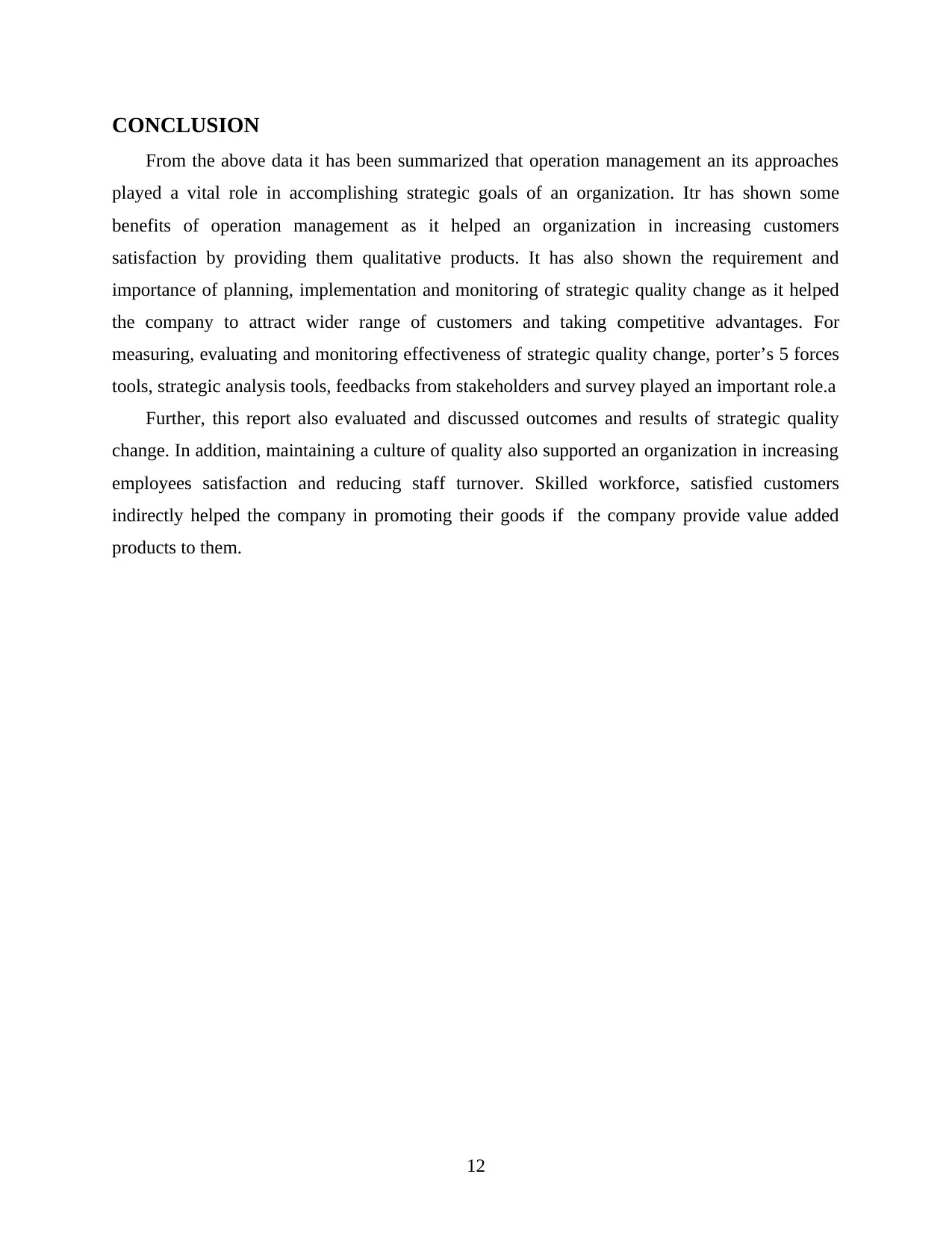
CONCLUSION
From the above data it has been summarized that operation management an its approaches
played a vital role in accomplishing strategic goals of an organization. Itr has shown some
benefits of operation management as it helped an organization in increasing customers
satisfaction by providing them qualitative products. It has also shown the requirement and
importance of planning, implementation and monitoring of strategic quality change as it helped
the company to attract wider range of customers and taking competitive advantages. For
measuring, evaluating and monitoring effectiveness of strategic quality change, porter’s 5 forces
tools, strategic analysis tools, feedbacks from stakeholders and survey played an important role.a
Further, this report also evaluated and discussed outcomes and results of strategic quality
change. In addition, maintaining a culture of quality also supported an organization in increasing
employees satisfaction and reducing staff turnover. Skilled workforce, satisfied customers
indirectly helped the company in promoting their goods if the company provide value added
products to them.
12
From the above data it has been summarized that operation management an its approaches
played a vital role in accomplishing strategic goals of an organization. Itr has shown some
benefits of operation management as it helped an organization in increasing customers
satisfaction by providing them qualitative products. It has also shown the requirement and
importance of planning, implementation and monitoring of strategic quality change as it helped
the company to attract wider range of customers and taking competitive advantages. For
measuring, evaluating and monitoring effectiveness of strategic quality change, porter’s 5 forces
tools, strategic analysis tools, feedbacks from stakeholders and survey played an important role.a
Further, this report also evaluated and discussed outcomes and results of strategic quality
change. In addition, maintaining a culture of quality also supported an organization in increasing
employees satisfaction and reducing staff turnover. Skilled workforce, satisfied customers
indirectly helped the company in promoting their goods if the company provide value added
products to them.
12
⊘ This is a preview!⊘
Do you want full access?
Subscribe today to unlock all pages.

Trusted by 1+ million students worldwide
1 out of 13
Related Documents
Your All-in-One AI-Powered Toolkit for Academic Success.
+13062052269
info@desklib.com
Available 24*7 on WhatsApp / Email
![[object Object]](/_next/static/media/star-bottom.7253800d.svg)
Unlock your academic potential
Copyright © 2020–2025 A2Z Services. All Rights Reserved. Developed and managed by ZUCOL.





